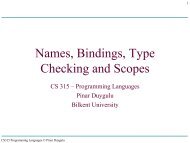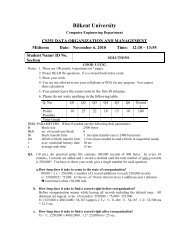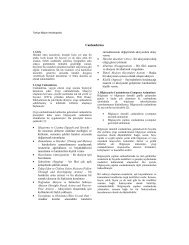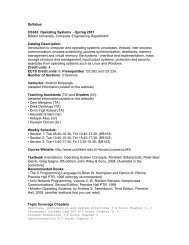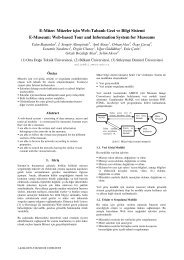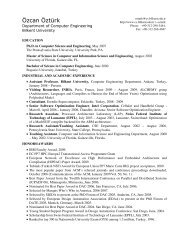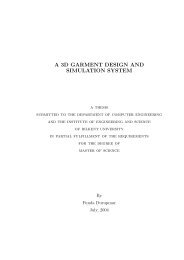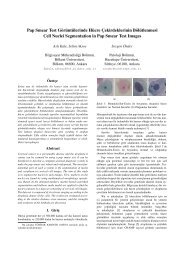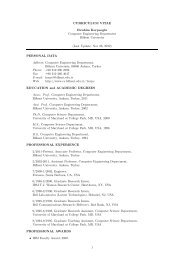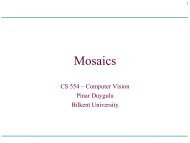On Probability of Success in Linear and ... - Bilkent University
On Probability of Success in Linear and ... - Bilkent University
On Probability of Success in Linear and ... - Bilkent University
You also want an ePaper? Increase the reach of your titles
YUMPU automatically turns print PDFs into web optimized ePapers that Google loves.
�<br />
σq is negligible <strong>and</strong> we can assume σ2 0 + σ2 q ≈ σ0. Then (9) becomes<br />
PS =<br />
=<br />
� ∞<br />
− µ 0−µq σ0 � ∞<br />
φ(x) dx (10)<br />
−2 √ N(|p−1/2|−F −1<br />
w (1−2 −a ))<br />
φ(x) dx , (11)<br />
where the success probability is a function <strong>of</strong> the advantage level a, <strong>in</strong>dependent<br />
<strong>of</strong> the number <strong>of</strong> key bits attacked m.<br />
In (11), Fw is the folded normal distribution FN (0, σ 2 w), <strong>and</strong> F −1<br />
w (1−2 −a ) =<br />
σwΦ −1 (1 − 2 −a−1 ) for σw = 1/(2 √ N), yield<strong>in</strong>g the follow<strong>in</strong>g ma<strong>in</strong> result:<br />
Theorem 2. Let PS be the probability that a l<strong>in</strong>ear attack on an m-bit subkey,<br />
with a l<strong>in</strong>ear approximation <strong>of</strong> probability p, with N known pla<strong>in</strong>text blocks,<br />
delivers an a-bit or higher advantage. Assum<strong>in</strong>g that the l<strong>in</strong>ear approximation’s<br />
probability to hold is <strong>in</strong>dependent for each key tried <strong>and</strong> is equal to 1/2 for all<br />
wrong keys, we have, for sufficiently large m <strong>and</strong> N,<br />
PS = Φ<br />
�<br />
2 √ N|p − 1/2| − Φ −1 (1 − 2 −a−1 �<br />
)<br />
. (12)<br />
A numerical calculation <strong>of</strong> (12) is shown <strong>in</strong> Table 2, where the success probability<br />
is given as a function <strong>of</strong> the aimed advantage level a <strong>and</strong> cN , the amount<br />
<strong>of</strong> available pla<strong>in</strong>texts as a multiple <strong>of</strong> |p − 1/2| −2 (i.e., cN = N/|p − 1/2| −2 ). A<br />
comparison <strong>of</strong> the columns <strong>of</strong> Table 1 to the column <strong>of</strong> Table 2 for cN = 8 shows<br />
that the two are almost identical.<br />
a cN = 2 cN = 4 cN = 8 cN = 16 cN = 32 cN = 64<br />
8 0.477 0.867 0.997 1.000 1.000 1.000<br />
16 0.067 0.373 0.909 1.000 1.000 1.000<br />
32 0.000 0.010 0.248 0.952 1.000 1.000<br />
48 0.000 0.000 0.014 0.552 0.999 1.000<br />
Table 2. <strong>Probability</strong> <strong>of</strong> achiev<strong>in</strong>g an a-bit advantage with N = cN |p − 1/2| −2 pla<strong>in</strong>texts,<br />
accord<strong>in</strong>g to equation (12).<br />
Equation (12) implies that 2 √ N|p − 1/2| − Φ −1 (1 − 2 −a−1 ) = Φ −1 (PS),<br />
yield<strong>in</strong>g a direct formula to calculate the required number <strong>of</strong> pla<strong>in</strong>texts to achieve<br />
a certa<strong>in</strong> success probability PS:<br />
Corollary 1. With the assumptions <strong>of</strong> Theorem 2,<br />
� −1 Φ (PS) + Φ<br />
N =<br />
−1 (1 − 2−a−1 )<br />
2<br />
�2<br />
· |p − 1/2| −2<br />
pla<strong>in</strong>text blocks are needed <strong>in</strong> a l<strong>in</strong>ear attack to accomplish an a-bit advantage<br />
with a success probability <strong>of</strong> PS.<br />
6<br />
(13)




